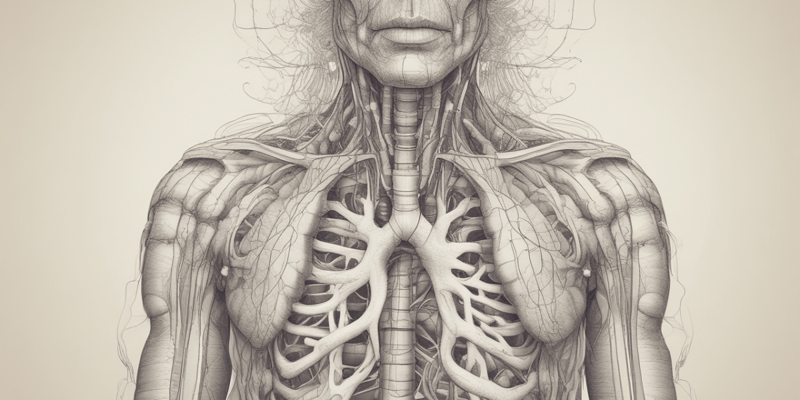Podcast Beta
Questions and Answers
Which structures make up the upper respiratory tract?
What is a function of the respiratory system?
The larynx is also known as the voice box.
True
What separates the nasal cavity from the oral cavity?
Signup and view all the answers
The __________ is a muscular passage from the nasal cavity to the larynx.
Signup and view all the answers
What are the two phases of breathing?
Signup and view all the answers
Which of the following organs are part of the respiratory system?
Signup and view all the answers
The vocal cords vibrate to produce sound.
Signup and view all the answers
The __________ prevents food and drink from entering the airway when swallowing.
Signup and view all the answers
Match the following structures with their functions:
Signup and view all the answers
Study Notes
Respiratory System Organization
- The respiratory system consists of the upper respiratory tract (nose to pharynx) and the lower respiratory tract (larynx onwards).
- The conducting portion of the respiratory system is responsible for air transport and includes the nose, nasal cavity, pharynx, larynx, trachea, and bronchi.
- The respiratory portion is responsible for gas exchange and includes the respiratory bronchioles, alveolar ducts, and alveoli.
Upper Respiratory Tract
- The upper respiratory tract consists of the nose and nasal cavity, paranasal sinuses, and pharynx.
Organs of the Respiratory System
- The respiratory system is composed of the nose, pharynx, larynx, trachea, bronchi, and lungs, which contain alveoli.
Respiratory System Functions
- The respiratory system is vital for oxygen supply and carbon dioxide removal.
- It filters inspired air, produces sound, contains smell receptors, eliminates excess water and heat, and regulates blood pH.
Breathing
- Breathing, also known as pulmonary ventilation, involves inhalation (inspiration) and exhalation (expiration).
The Nose
- The nose varies in size due to nasal cartilage differences.
- The nose is divided by the nasal septum, and is continuous with the nasopharynx.
Nasal Cavity Anatomy
- The lateral walls of the nasal cavity have projections called conchae, which increase surface area and air turbulence.
- The nasal cavity is separated from the oral cavity by the palate, which is composed of the hard palate (bone) anteriorly and the soft palate (muscle) posteriorly.
Paranasal Sinuses
- Paranasal sinuses are cavities within bones surrounding the nasal cavity, specifically the frontal, sphenoid, ethmoid, and maxillary bones.
- The sinuses lighten the skull, act as resonance chambers for speech, and produce mucus that drains into the nasal cavity.
Pharynx (Throat)
- The pharynx is a muscular passageway from the nasal cavity to the larynx.
- It is divided into three regions: the nasopharynx (superior behind the nasal cavity), the oropharynx (middle behind the mouth), and the laryngopharynx (inferior attached to the larynx).
- The oropharynx and laryngopharynx are common passageways for air and food.
Larynx (Voice Box)
- The larynx is a cylindrical airway that ends in the trachea.
- It prevents swallowed materials from entering the lower respiratory tract, conducts air into the lower respiratory tract, and produces sounds.
- It is supported by nine cartilage pieces held in place by ligaments and muscles.
Larynx Components
- Nine (9) c-rings of cartilage form the framework of the larynx.
- These include the thyroid cartilage, cricoid cartilage, arytenoid cartilages, cuneiform cartilages, corniculate cartilages, and epiglottis.
Larynx Function
- The muscular walls of the larynx aid in voice production and the swallowing reflex.
- The glottis is the superior opening of the larynx.
- The epiglottis prevents food and drink from entering the airway when swallowing.
Larynx Structure
- Vocal cords (vocal folds) vibrate with expelled air to create sound (speech).
- The glottis is the opening between the vocal cords.
Sound Production
- Sound production involves the intermittent release of exhaled air through the vocal folds.
- Loudness depends on the force with which air is exhaled through the cords.
- The pharynx, oral cavity, nasal cavity, and paranasal sinuses act as resonating chambers that add quality to the sound.
- Muscles of the face, tongue, and lips help with the enunciation of words.
Vocal Fold Movements
- Vocal adduction brings the vocal folds together, while vocal abduction separates them.
- The tension, length, and position of the vocal folds determine the quality of the sound.
The Larynx and Voice Production
- The length of the vocal folds changes with pitch.
- Loudness depends on the force of air across the vocal folds.
- The intrinsic muscles of the larynx include the lateral cricoaytenoid (vocal adduction) and the posterior cricoaytenoid (vocal abduction).
- The larynx is innervated by the recurrent laryngeal nerves, a branch of the Vagus nerve.
Studying That Suits You
Use AI to generate personalized quizzes and flashcards to suit your learning preferences.
Related Documents
Description
Explore the organization and functions of the respiratory system, including the upper and lower respiratory tracts. This quiz covers key components such as air transport, gas exchange, and the various organs involved in respiration.




